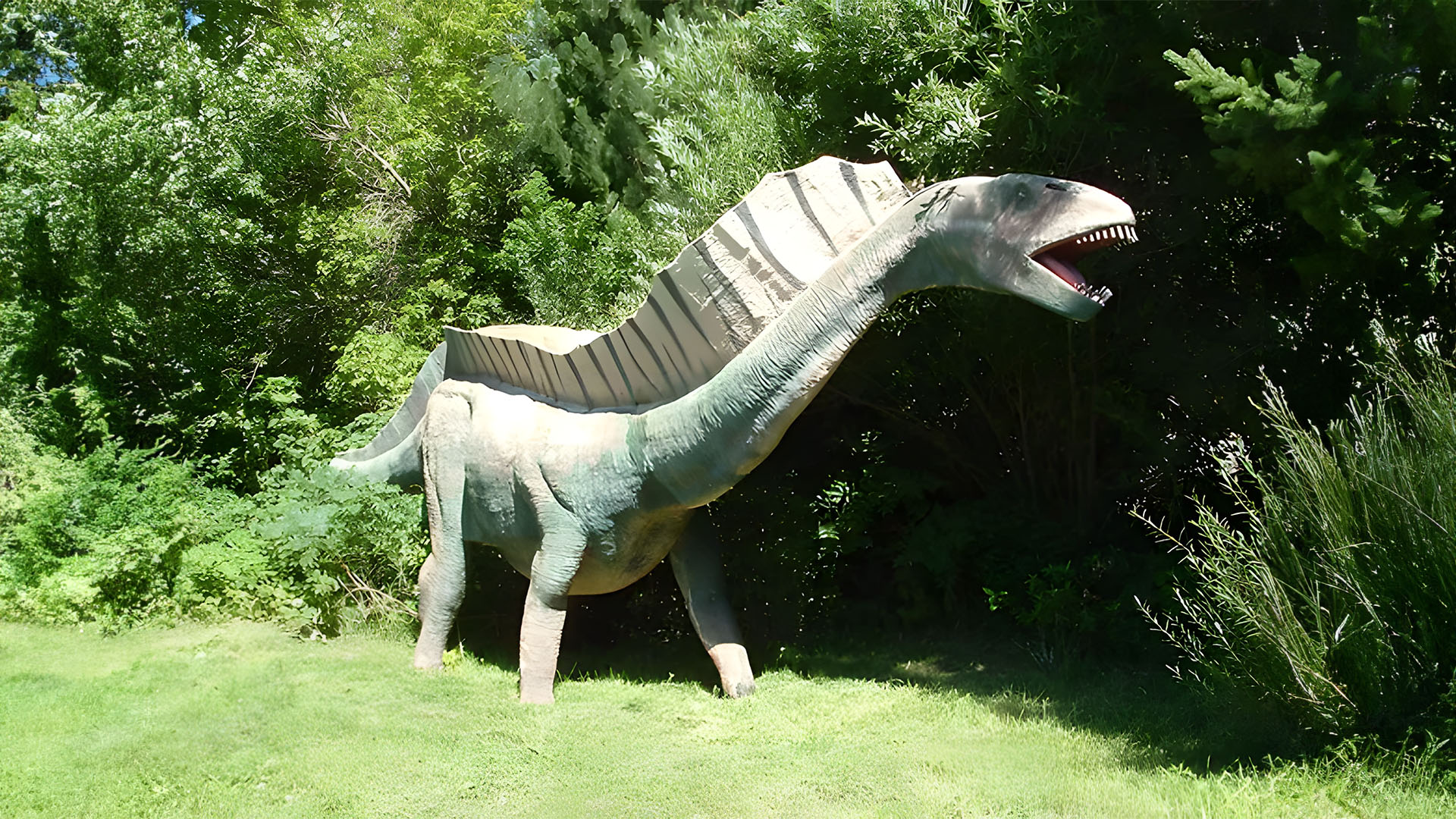Why do theropods get all the attention? I’m not just some vanilla sauropod! Sheesh, I grow these neck spines and no one pays me any attention, same as ever. What’s a saurian gotta do to catch a break, huh?
I need a new paint job. The sun’s too bright. Grumble, grumble, grumble.
- This animal’s name refers to the La Amarga formation where it was discovered, while its species name honors Dr. Luis Cazau, who suggested the formation for paleontological exploration. However, “amarga” means “bitter” in Spanish, so its name can translate as “Cazau’s Bitter Lizard.” Now the picture caption makes sense, yes? Also, its species name sounds like “kazowie,” which is awesome.
- Though only one skeleton of this animal has so far been discovered, it was relatively complete and in good condition. Skull elements from sauropods are rare, but scientists did find the back of Amargasaurus’ head, as well as most of the skeleton for the torso and limbs. They only managed to recover a few tail bones, however, and the base of the hips—the sacrum—was damaged by erosion at some point in the past.
- Amargasaurus belonged to a strange group of southern sauropods called the dicraeosaurs. Though closely related to Diplodocus and its kin, these animals didn’t attain the enormous sizes of many of their cousins (if 30ft and 3 tons counts as “not enormous”) and had unusually short necks made up of oddly-shaped vertabrae. Their strange body plans suggest they filled ecological niches that either didn’t exist in the northern hemisphere in the late Jurassic/early Cretaceous or that they filled the same niches occupied by different types of dinosaurs in the north.
- Scientists interpret its short legs and hip construction to mean that it couldn’t raise up on its hind legs like some other sauropods might have, and that it was exceptionally slow. Consequently, some of them interpret the bizarre dual rows of spines on its neck as defensive features—a theory bolstered by the recent discovery of a similar taxon, Bajadasaurus. Only the skull and first few bones of the neck represent Bajadasaurus, but reconstructions extrapolating the missing neck bones using Amargasaurus as a template suggest an even more radical set of punk-rock neck spikes. Scientists who described Bajadasaurus suggest that even if the neck spines proved too thin and easy to damage to put up a real physical defense, they looked impressive enough to bluff predators.
- The past couple of years have turned up yet another Amargasaurus look-alike: Pilmatueia. It’s probably only a matter of time before some systematist suggests naming their clade amargasaurines, and more power to ’em!
- Our reconstruction at the park portrays one early theory that gained greater popularity: a skin-covered fin running down the neck toward the back. Scientists do believe that some sort of integument like skin or horn covered those spines because of rough patterns on their surfaces that could serve as attachment points for softer materials. However,since the spines run parallel to each other only a few inches apart, they probably didn’t represent the dual fins seen on our Amargasaurus. The spine rows also converge into one large hump just before the hips, not afterward like on our version. If the sculpture can offer any insight on the practicality of a dual fin, it’s this: those fins would act like natural gutters for collecting water and all sorts of plant detritus. High maintenance? You bet.
- Several lines of evidence suggest that sauropods, including Amargasaurus, had a bird-like lung structure. Their lungs couldn’t expand like ours; instead, they were powered by air sacs attached to the lungs but hidden inside the animal’s skeleton. These air sacs helped lighten their bones, which came in especially handy for dealing with the physics of a long neck. The sacs may have served other functions as well, like temperature management, vocal resonance, or possibly helped lessen the energy cost of keeping the neck in position (kind of like how compressed air moves animatronic dinosaurs, except that they would have worked in a more passive way to provide extra support). Even though Amargasaurus had a shorter neck than most sauropods, it still had the air sacs—in fact, the lower third of those neck spines may have concealed a whole series of them. Since science has yet to discover all the functions of these sacs in birds, their function in dinosaurs remains even more mysterious.
Salgado, L., & Bonaparte, J. F. (1991). A new dicraeosaurid sauropod, Amargasaurus cazaui gen. et. sp. nov., from the La Amarga Formation, Neocomian of Neuquen Province, Argentina. Ameghiniana, 28, 333-346.
Gallina, P. A., Apesteguía, S., Canale, J. I., & Haluza, A. (2019). A new long-spined dinosaur from Patagonia sheds light on sauropod defense system. Scientific reports, 9(1), 1-10.
Coria, R. A., Windholz, G. J., Ortega, F., & Currie, P. J. (2019). A new dicraeosaurid sauropod from the Lower Cretaceous (Mulichinco Formation, Valanginian, Neuquén Basin) of Argentina. Cretaceous Research, 93, 33-48.
Schwarz, D., Frey, E., & Meyer, C. A. (2007). Pneumaticity and soft-tissue reconstructions in the neck of diplodocid and dicraeosaurid sauropods. Acta Palaeontologica Polonica, 52(1).
